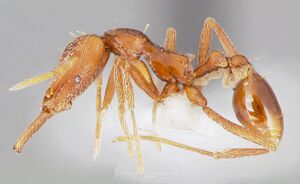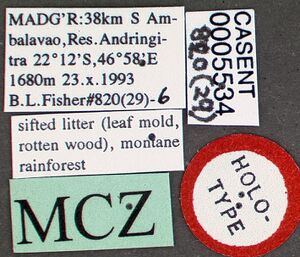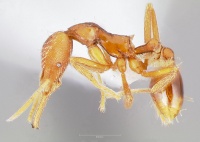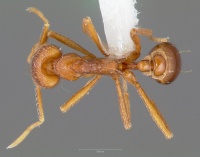Strumigenys europs
| Strumigenys europs | |
|---|---|

| |
| Scientific classification | |
| Kingdom: | Animalia |
| Phylum: | Arthropoda |
| Class: | Insecta |
| Order: | Hymenoptera |
| Family: | Formicidae |
| Subfamily: | Myrmicinae |
| Tribe: | Attini |
| Genus: | Strumigenys |
| Species: | S. europs |
| Binomial name | |
| Strumigenys europs Fisher, 2000 | |
Known from higher elevation forest habitats with collections obtained from litter samples and a single soil collection.
Identification
Bolton (2000) - A member of the scotti complex in the Strumigenys scotti-group. S. europs is most similar to Strumigenys finator and both can be distinguished from other species in the scotti-complex by having the mesonotum with one pair of stiff hairs and dorsum of petiole more or less smooth and shiny. S. europs and jinator differ as follows.
S. europs
1 Postpetiole disc with a pair of hairs on posterior margin only.
2 Dorsum of petiole usually without hairs.
3 In full-face view hairs on upper scrobe margin decumbent and sharply bent at basal third.
4 Propodeal lamella well developed, widest section usually distinctly greater in width than eye.
5 Head longer and broader, HL 0.78-0.86, HW 0.52-0.59.
S. jinator
1 Postpetiole disc with three pairs of filiform hairs.
2 Dorsum of petiole always with a pair of hairs.
3 In full-face view hairs on upper scrobe margin subdecumbent to suberect, curved through entire length.
4 Propodeal lamella represented by an inconspicuous, very narrow lamellate ridge.
5 Head shorter and narrower, HL 0.57-0.64, HW 0.44-0.50.
Keys including this Species
Distribution
Latitudinal Distribution Pattern
Latitudinal Range: -22.2° to -22.2°.
| North Temperate |
North Subtropical |
Tropical | South Subtropical |
South Temperate |
- Source: AntMaps
Distribution based on Regional Taxon Lists
Malagasy Region: Madagascar (type locality).
Distribution based on AntMaps
Distribution based on AntWeb specimens
Check data from AntWeb
Countries Occupied
| Number of countries occupied by this species based on AntWiki Regional Taxon Lists. In general, fewer countries occupied indicates a narrower range, while more countries indicates a more widespread species. |

|
Estimated Abundance
| Relative abundance based on number of AntMaps records per species (this species within the purple bar). Fewer records (to the left) indicates a less abundant/encountered species while more records (to the right) indicates more abundant/encountered species. |

|
Biology
Castes
Worker
Images from AntWeb
   
| |
| Holotype of Strumigenys europs. Worker. Specimen code casent0005534. Photographer April Nobile, uploaded by California Academy of Sciences. | Owned by MCZ, Cambridge, MA, USA. |
Nomenclature
The following information is derived from Barry Bolton's Online Catalogue of the Ants of the World.
- europs. Strumigenys europs Fisher, in Bolton, 2000: 680 (w.) MADAGASCAR.
Unless otherwise noted the text for the remainder of this section is reported from the publication that includes the original description.
Description
Worker
Holotype. TL 3.5, HL 0.85, HW 0.59, CI 69, ML 0.45, MI 53, SL 0.57, SI 96, PW 0.36, AL 0.95. Characters of scotti-complex. Mandibles in full-face view with outer margins very shallowly and evenly convex, the width approximately constant from the level of the proximal preapical tooth to near the base. Upper scrobe margin evenly and shallowly convex in full-face view, not bordered by a rim or flange, the eyes visible, the apices of the upper scrobe margins confluent with the sides of the occipital lobes through an even curve, without an angle separating the two. Maximum diameter of eye slightly greater than maximum width of scape, with 5 - 6 ommatidia in longest row. Scape narrow and subcylindrical, shallowly and gently curved; hairs on leading edge narrow and decumbent, sharply bent at basal third and flattened or spoon-shaped apically. Cephalic dorsum densely clothed with rows of appressed, narrow, spatulate or spoon-shaped ground pilosity, the upper scrobe margin fringed with hairs which are longer but similar in shape as those on the dorsum. Cephalic dorsum with 6 stout standing hairs arranged in a transverse row of 4 close to the occipital margin and a more anteriorly situated pair. Pronotal humeral hair flagellate; humeral angles rounded, lateral margin of posterior pronotum with a marginate projection. Mesonotum with a pairs of stout filiform hairs on the anterior margin. Propodeum with two pairs of short, fine, posteriorly curved hairs immediately anterior of propodeal spines. Dorsal alitrunk with sparse ground-pilosity that is similar in shape to pilosity on head. Dorsum of alitrunk in outline convex anteriorly and more or less flat posteriorly. Metanotal groove represented by a raised transverse ridge across the dorsum. Anterior mesonotum with a narrow flange above the mesothoracic spiracle; mesopleural hair organ set in a large circular notch. Propodeal tooth broadly triangular, spongiform, lamellate, pointed apically, subtended by a moderate lamella on declivity. Pronotal dorsum shiny, longitudinally rugulose with superficial punctures laterally. Mesonotal and propodeal dorsum densely reticulate-punctate. Sides of alitrunk smooth, reticulate-punctate peripherally and along vertical groove above mesopleural gland. Dorsum of petiole node smooth with faint punctate sculpture that appears almost effaced; postpetiole disc smooth and shiny. Spongiform appendages of waist segments greatly expanded, petiole with a well developed ventral strip. Basigastral costulae sharply defined, radiating on each side of a central clear area. Dorsal surface of petiole without standing hairs. postpetiole disc with a pair of filiform hairs on posterior margin only. Dorsal gaster with standing filiform hairs. Colour light brown.
Paratypes. TL 3.4-3.6, HL 0.79-0.85, HW 0.53-0.56, CI 65-67, ML 0.42-0.45, MI 52-55, SL 0.53-0.58, SI 100-108, PW 0.34-0.36, AL 0.88-0.94 (3 measured). One specimen with a less developed propodeal lamella, otherwise as holotype.
Measurements of this material extend the range shown by the type-series: HL 0.78-0.86, HW 0.52-0.57, CI 62-68, ML 0.40-0.45, MI 51-55, SL 0.51-0.57 (8 measured). One of the three specimens from Itremo differed from the type-material by having a pair of standing hairs on the petiolar disc.
Type Material
Holotype worker, Madagascar: 38 km. S Ambalavao, Res. Andringitra, 22°12'S, 46°58'E, 1680 m., 23.x.1996, sifted litter (leaf mold, rotten wood), montane rainforest, #820 (29)-6 (B. L. Fisher) (Museum of Comparative Zoology).
Paratypes. 3 workers with same data as holotype but coded (21)-4, (35)-4, (48)-5 (The Natural History Museum, South African Museum).
References
- Fisher, B.L. 2000. The Malagasy fauna of Strumigenys. Pp. 612-696 in: Bolton, B. 2000. The ant tribe Dacetini. Memoirs of the American Entomological Institute. 65:1-1028. (page 680, worker described)
References based on Global Ant Biodiversity Informatics
- Bolton, B. 2000. The Ant Tribe Dacetini. Memoirs of the American Entomological Institute 65
- Fisher B. L. 2003. Formicidae, ants. Pp. 811-819 in: Goodman, S. M.; Benstead, J. P. (eds.) 2003. The natural history of Madagascar. Chicago: University of Chicago Press, xxi + 1709 pp.

